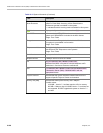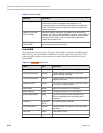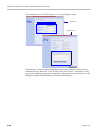
Chapter 21-Collaboration ServerAdministration and Utilities
Polycom, Inc. 21-35
3 Alarm Fault trap. The third trap type is a family of traps defined in the POLYCOM-
RMX-MIB file, these traps are associated with the Collaboration Server active alarm and
clearance (proprietary SNMP trap).
Figure 3 An Example of an Alarm Fault Trap
Each trap is sent with a time stamp, the agent address, and the manager address.
Status Trap
The MCU sends status traps for the status MAJOR - a trap is sent when the card/MCU
status is MAJOR.
All traps are considered “MAJOR”.
RMX MIB entities that do not generate traps.
The following table lists the entities that appear in the RMX MIB of the SNMP that do not
generate traps. These traps will be displayed as Faults in the System Alerts pane (at the
bottom of the Collaboration Server (RMX) Web Client screen.
Table 21-16 SNMP MIB entities that do not generate traps
Key Description Comment
5002 Resource process did not receive the Meeting Room list during
startup.
5004 Task terminated
5008 Low Processing Memory
5009 Low system Memory
5010 High system CPU usage
5014 High CPU utilization
rmxFailedConfigUserListInLinuxAlarmFault notification received
from: 172.22.189.154 at 5/20/2007 7:04:22 PM
Time stamp: 0 days 00h:01m:11s.71th
Agent address: 172.22.189.154 Port: 32777 Transport: IP/UDP
Protocol: SNMPv2c Notification
Manager address: 172.22.172.34 Port: 162 Transport: IP/UDP
Community: public
Bindings (6)
Binding #1: sysUpTime.0 *** (timeticks) 0 days
00h:01m:11s.71th
Binding #2: snmpTrapOID.0 *** (oid)
rmxFailedConfigUserListInLinuxAlarmFault
Binding #3: rmxAlarmDescription *** (octets) Insufficient
resources
Binding #4: rmxActiveAlarmDateAndTime *** (octets) 2007-6-
19,16:7:15.0,0:0
Binding #5: rmxActiveAlarmIndex *** (gauge32) 2
Binding #6: rmxActiveAlarmListName *** (octets) Active
Alarm Table
* Binding #7: rmxActiveAlarmRmxStatus *** (rmxStatus) major


















